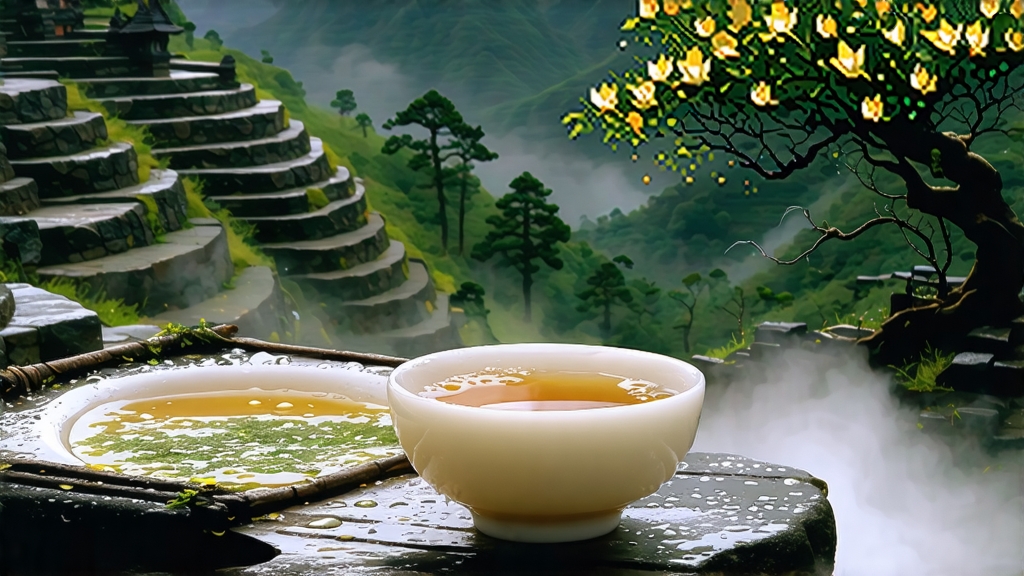
Among the six chromatic families of Chinese tea, yellow tea is the rarest, often called the “imperial ghost” because its production volume is less than 0.5 % of China’s total tea output. Within this elusive category, Meng Ding Huang Ya from Ya’an, Sichuan, is the oldest continuously produced yellow tea, its pedigree stretching back to the Tang dynasty (618-907 CE) when it was listed as a tribute in the “Cha Jing” by Lu Yu. Today it remains a living fossil of craftsmanship, a leaf that whispers the taste of mountain mist, Buddhist discipline and the slow alchemy of micro-fermentation.
History: from palace to panda land
Meng Ding Mountain rises abruptly above the western rim of the Sichuan basin, its summit permanently wrapped in a 200-day-a-year fog generated by the convergence of the Min River and moist monsoon air. During the Tang court, mule caravans carried the first spring buds 1 800 km north to Chang’an, a journey of 28 days, so that the emperor could perform the Vernal Equinox tea rite. Song chronicles record that the tea was “wrapped in yellow silk, stored in silver caskets, opened only when the palace orchids bloomed.” After the tribute system collapsed in 1911, the technique survived among monks at the Gan-Deng Temple on Meng Ding, who bartered tea for medicinal herbs. Rediscovery came in 1959 when a Sichuan trade delegation seeking export revenue re-documented the process; the tea re-entered global consciousness at the 1982 Hamburg Food Fair, where buyers christened it “Sichuan’s liquid topaz.”
Micro-ecology: why the mountain matters
The garden zone sits between 800 m and 1 400 m, a sweet spot where mean annual temperature is 14.7 °C and humidity 83 %. The soil is acid yellow loam derived from phyllite, rich in ion-exchangeable potassium (185 mg kg⁻¹) and selenium (0.54 mg kg⁻¹), elements that translate into a naturally sweet cup. Because the mountain is a national panda corridor, pesticide use is banned; instead, growers plant aromatic citronella grass every seventh row to confuse leafhoppers. The indigenous cultivar is the “Meng Ding #9” seedling, a slow-growing bush whose one-centimetre buds accumulate 4.2 % theanine—almost double that of平原 (plain) bushes.
Pluck standard: one bud, no leaf, before Qingming
The picking window opens five days before the solar term Qingming (around 4 April) and closes ten days later. Only the unopened bud, sheathed in two silvery scales, is taken. A skilled picker gathers 600 g fresh weight in a dawn shift, enough for barely 120 g finished tea. The pluck is transported down the slope in bamboo baskets lined with banana leaves to prevent compression oxidation.
Craft: the secret of “sealed yellowing”
Yellow tea’s defining step is men huang (闷黄), a controlled re-warming that yellows the chlorophyll and coaxes a non-enzymatic browning akin to a micro-bolus of oxidation trapped between green and oolong. Meng Ding Huang Ya uses the “three seals, three bakes” variant:
- Sha-qing (kill-green): 180 °C drum roast for 2 min 40 s to 58 % moisture.
- Chu bao (first wrap): the hot leaf is piled 8 cm deep inside a linen sack, then slid into a pre-heated stone trough at 38 °C for 3 h; the core temperature climbs to 45 °C, chlorophyll begins to hydrolyse.
- Yi hong (first bake): charcoal ember pan at 90 °C for 6 min to lower moisture to 35 %.
- Er bao (second wrap): the leaf is re-wrapped, this time with a layer of wet parchment to raise humidity to 75 %; 4 h rest.
- Er hong: 80 °C bake to 20 % moisture.
- San bao (third wrap): the most delicate, 6 h at 32 °C; technicians listen for a faint popcorn note that signals the Maillard corridor has opened.
- Zu hong (final bake): 60 °